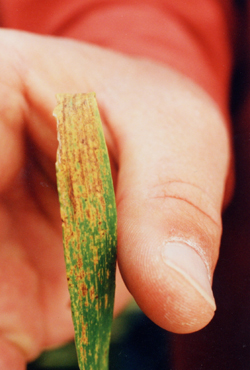
Picture: Bravo 500 - now approved against spotting in barley Bravo for barley growers as fungicide gets official approval against spotting 16 February 2004
WINTER and spring barley growers have a new fungicide choice to help tackle the serious, twin problems of Rhynchosporium and 'barley spotting'.
Bravo 500, from Syngenta, already has approval in a range of crops - including winter wheat, peas, beans and vegetables.
But a new approval for barley provides a breakthrough for growers, says Syngenta fungicide technical manager Rod Burke, since it is the only product to carry label approval for control of 'barley spotting'.
"The further north you go the more of a problem barley spotting becomes," says Mr Burke. "It is now one of the major diseases in Scotland and is probably equivalent to Rhynchosporium in importance. Basically, it just defoliates the plant.
"Yield loss can typically be 0.25 t/ha. But more important is the loss in grain size it can cause which can lose growers their malting premiums," he adds.
Caused by a variety of factors, 'barley spotting' has become more prevalent over recent seasons - though it is unclear why. It falls into two categories. Biotic spotting is believed to be caused by diseases including Ramularia, Alternaria and Botrytis, while abiotic spotting is caused by factors such as oxidative and nutrient stress and hypersensitive reactions within the plant.
"Fortunately, use of Bravo 500 in late season fungicide programmes has been shown to alleviate both types of spotting," adds Mr Burke.
"Adding Bravo 500 to a triazole in winter barley trial plots in North Yorkshire last year reduced abiotic spotting from 20% to just 3%. Effective reductions have also been seen in spring barley by adding Bravo 500 to strobilurin + triazole programmes," he adds.
"Also, Bravo 500 is a multi-site fungicide, which makes it harder for resistance to develop. So, as well as controlling barley spotting, addition of Bravo 500 to other fungicides makes it a useful anti-resistance partner too.
"It is also formulated with an advanced WeatherStik formulation designed to improve rainfastness. This is important since Rhynchosporium is a wet weather disease."
Maximum use rate of Bravo 500 in barley is 2.0 litres of product per hectare, with a maximum number of treatments of two per crop. Latest time of application is before growth stage 51 (first spikelet just visible) in barley.
"Bravo 500 must always be used with a tank mix partner as part of an integrated fungicide programme," Mr Burke stresses. Amistar (azoxystrobin) and Acanto (picoxystrobin) can be tank mixed with Bravo 500 at recommended rates.
